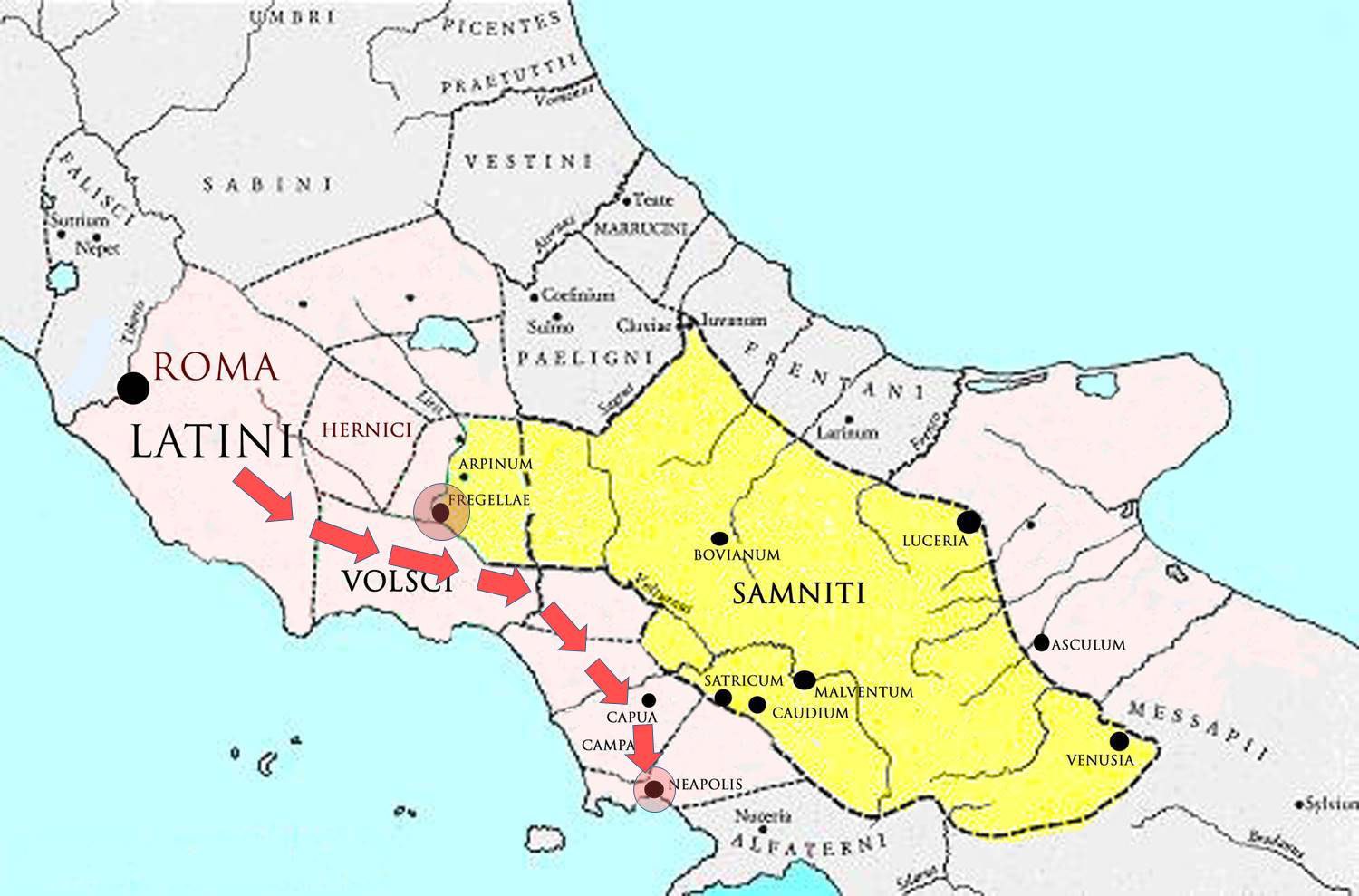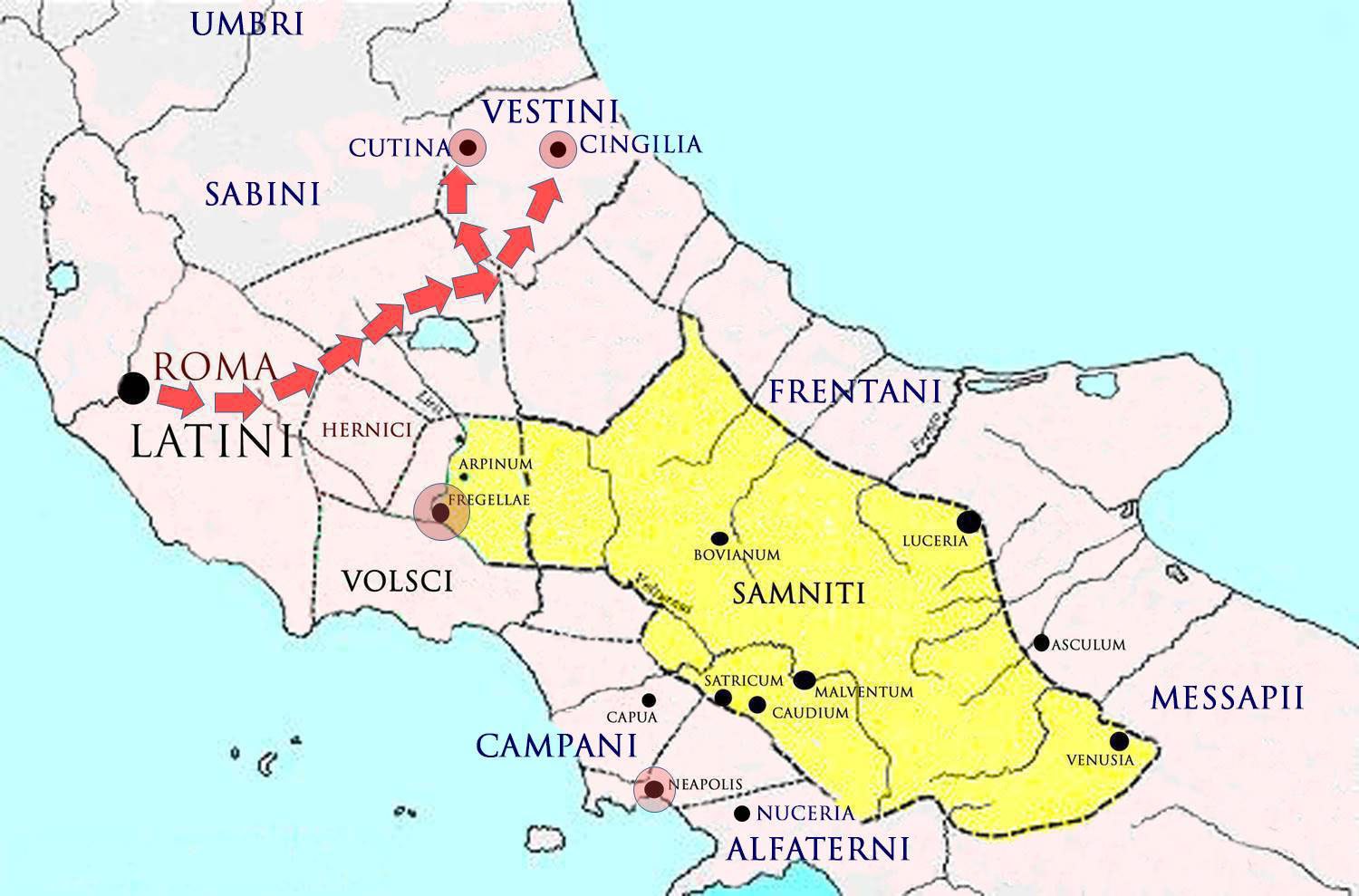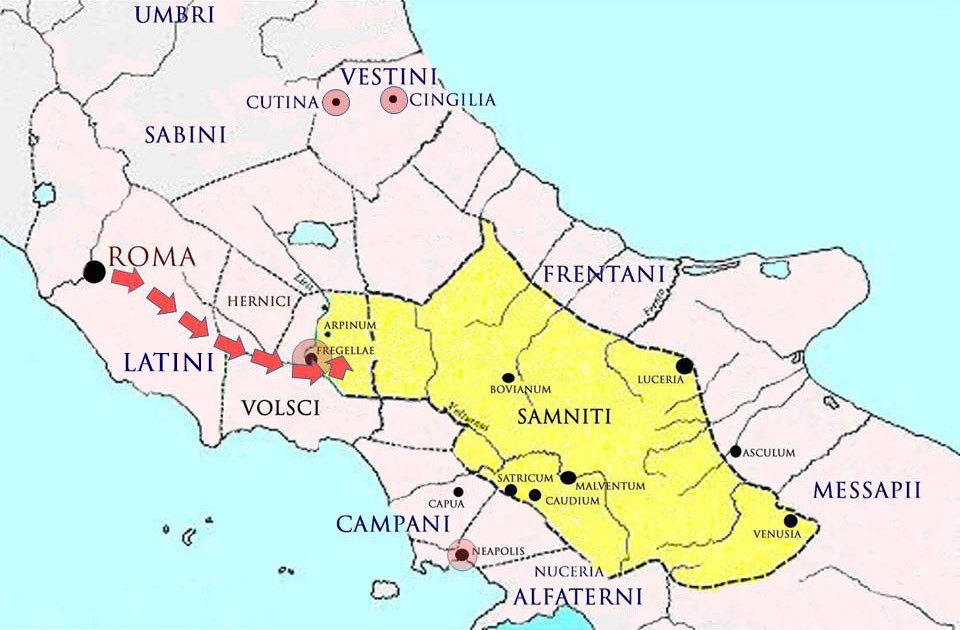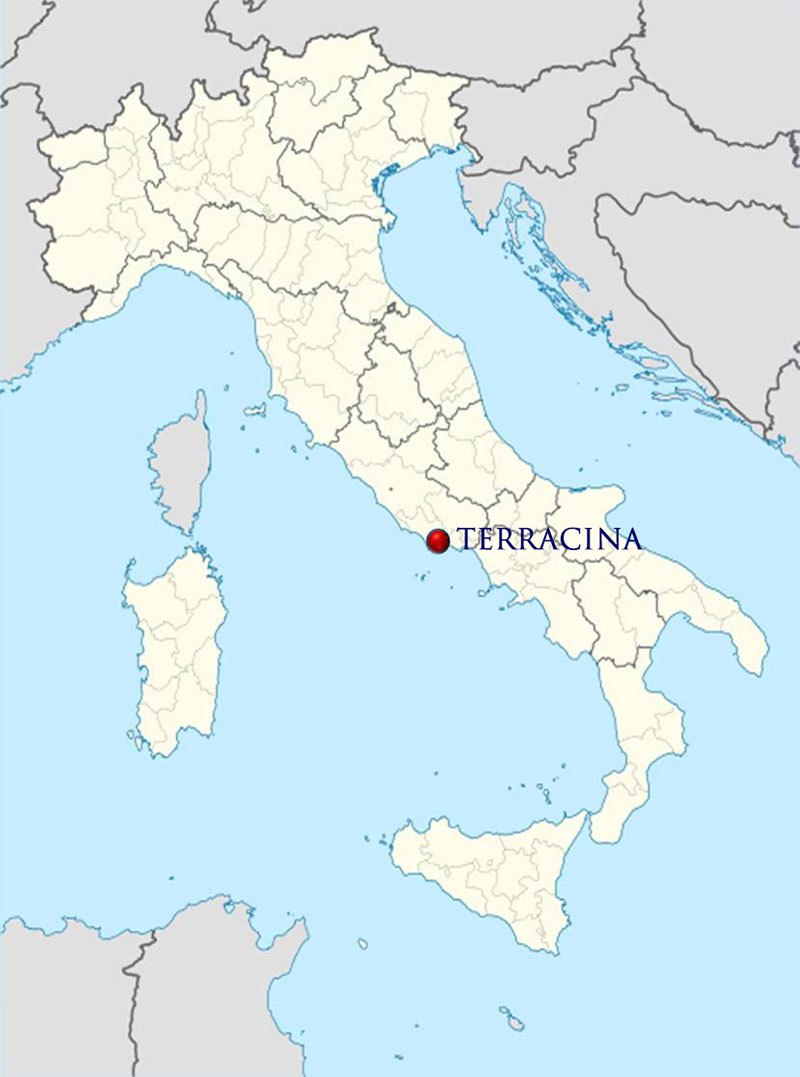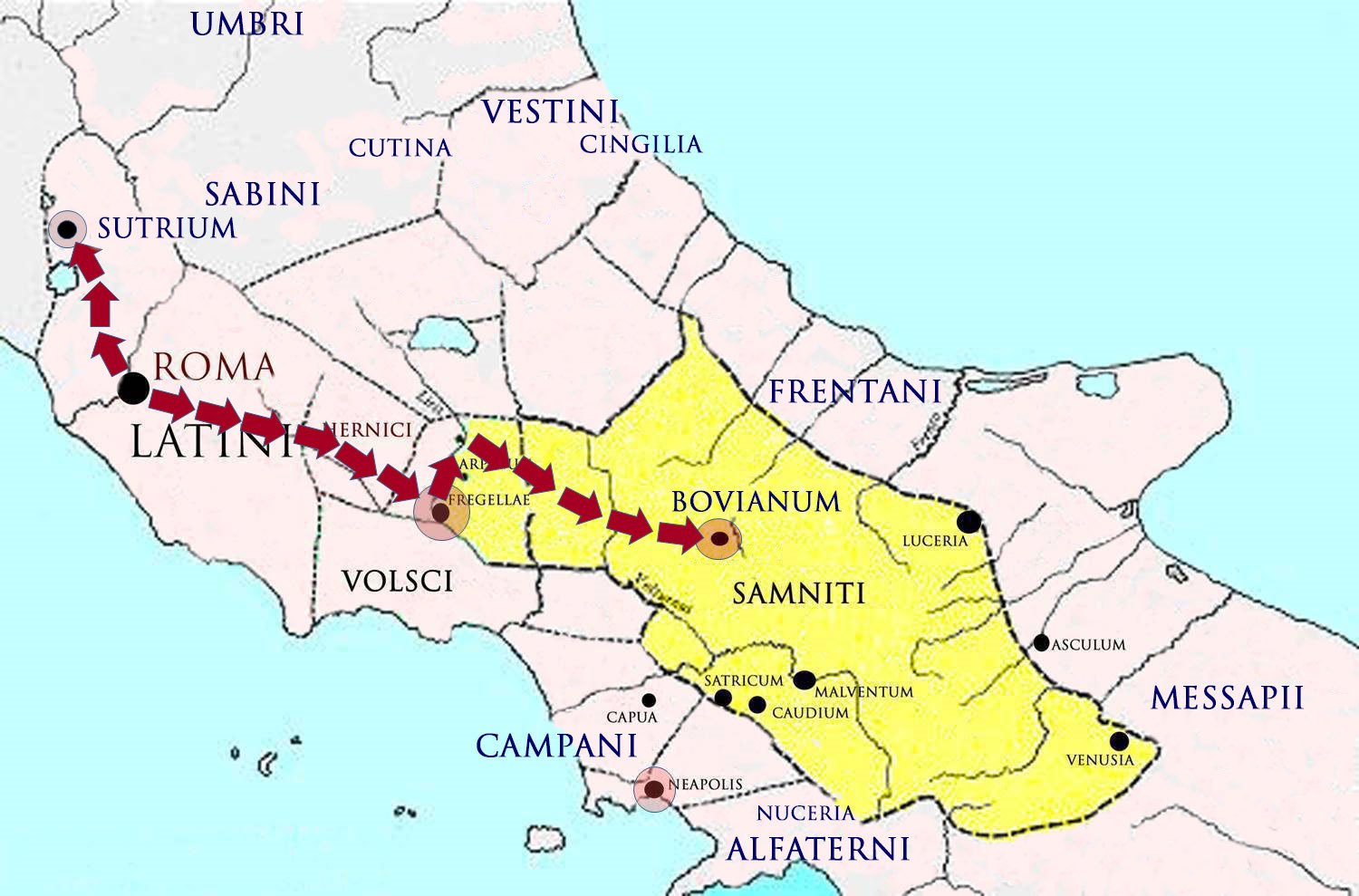Second Samnite War
Strategic View
Rome was a littoral power, in command of fertile plains (Latium and Campania) yet located on a navigable river (Tibur) near the sea, engaged in farming and trade. The state was fairly centralized with its Senate having a preeminent role in foreign affairs.
Rome was a sizable trading and political center with a relatively large population (akin to Athens and Attica in Greece). As with any entrepot, this meant a greater diversity of skilled workers. Despite their conservatism, the Romans were exposed to ideas from other cultures and they were willing to at least entertain if not adopt those ideas and habits they found useful.
The Roman political system was one of absorption. In other words, the Romans would generally absorb conquered cities and their polities into the Roman body politic with finely graded political and economic rights depending upon how those cities had entered the system. Particularly difficult or dangerous opponents were treated more harshly than city states that accepted Roman hegemony more readily. Usually, conquered cities were allowed local autonomy, with the Roman Senate exercising control over foreign and military affairs. The conquered cities were not taxed directly by Rome. Rather, in times of war, they were required to provide a military contingent commensurate with their population and wealth.
By the time of the Samnite wars, the Roman military was highly professional even though it was a citizen levy. Soldiers were paid and could, if necessary, fight year-round. Roman arms were of a high quality and soldiers were individually as well as collectively well trained. The cursus honorum ensured that the Romans always had a pool of well-trained and experienced senior field and staff officers who could effectively lead an army.
After the conquest of Veii and recovery from the sack of the city by the Gauls, Rome reached a takeoff stage where the state achieved an advantage over the Latin confederacy. They also achieved superiority over the Volsci and Hernici. All of these successes brought them into direct contact with another expansionist power; the Samnites. The bone of contention would initially be Campania, but the deeper underlying reason was the aggressive expansion of both peoples.
Samnium was located in the highlands of Italy, in the valleys that run through the Apennine Mountains. The Samnite nation was composed of 4 major tribes–the Hirpini, Caudini, Caraceni, and Pentri. There were also surrounded by peoples that were once Samnites (Oscan speaking) who had migrated to the periphery of Samnium (Apulia, Umbria, Campania, Lucania, and Bruttium) and mixed with other peoples (especially Greeks). Over time, these people developed a separate identity from those of central Samnium, essentially behaving as a separate people with separate cultures and separate political ambitions.
The manner of Samnite expansion has been preserved by ancient writers; that a religious ritual, the Sacred Spring (Ver Sacrum), caused the speakers of Oscan to push ever further along the Apennines with periodical descents into the plains on either side.
Below is an excerpt from E.T. Salmon Samnium and the Samnites.
In order to win a battle, avert a peril or end a natural calamity such as famine or plague, the Samnites would promise to sacrifice to Mamers everything that was born the following spring. The children born then grew up as sacrati and on reaching adulthood they were obliged to leave their tribe and seek fresh woods and pastures under the guidance of an animal that was sacred to the divinity.
The real motive for any Sacred Spring was overpopulation.
Unlike the Romans, the Samnites were composed of a loose political-religious confederation. Their expansionist efforts were a function of necessity and were more situational and episodic rather than strategic.
The population of Samnium was substantial. The economy, however, was comparatively rudimentary with respect to Rome; primarily farming and pastoral. The towns were not large or well developed as were those in Latium and Campania.
E. T. Salmon Samnium and the Samite Cambridge University Press New York 1967. Pages 34-36.
About the Samnites
Formation and Expansion of the Samnites
(Excerpt from E.T. Salmon Samnium and the Samnites)
The Osco-Umbrian peoples, who included both Samnites and Sabines, had evolved from the fusion of unidentifiable “aboriginals” with infiltrating Indo-Europeans and it may be further conjectured that they were evolving precisely during the centuries when the so-called “Apenninic” culture flourished. [See S.M. Puglisi, La Civilta Appenninica (1959)]
By 600 BC, distinct and separate Oscan-Umbrian tribes had come into being; and by 500 BC, the people known to history as the Samnites must have been clearly identifiably and in undisputed possession of Samnium. However, even by then, the process of tribal formation and consolidation was not at an end.
The manner in which individual Sabelian tribes came into being can be visualized to some extent from the tradition preserved by ancient writers that a religious ritual, the Sacred Spring (Ver Sacrum), caused the speakers of Oscan to push ever further along the Apennines with periodical descents into the plains on either side. Because this expansion was still going on during historical times, the ancient writers could not have been mistaken about this, its cardinal feature. The Ver Sacrum should not be dismissed as a mere aetiological fiction designed to explain why Sabines were sometimes called Sacrani. For that matter it was not confined to Sabellian Italy. Livy suggests that the Celts of Cisalpine Gaul had a very similar practice and he actually gives details of a sacred spring to which the Romans had recourse as a result of the crisis brought on by Hannibal’s invasion of Italy.
In order to win a battle, avert a peril or end a natural calamity such as famine or plague, the Sabellians would promise to sacrifice to Mamers everything that was born the following spring. The children born then grew up as sacrati and on reaching adulthood they were obliged to leave their tribe and seek fresh woods and pastures under the guidance of an animal that was sacred to the divinity.
The real motive for any Sacred Spring was overpopulation.
E. T. Salmon Samnium and the Samite Cambridge University Press New York 1967. Pages 34-36.
Distinction between Roman and Samnite expansion
Romans
- Roman expansion was slow and steady, characterized by compressed territory, the creation of fortresses and colonies
- Romans build relationships with the local aristocracies against democratic elements in various cities
- Romans usually broke apart or diminished political confederacies and replaced them with multiple bilateral agreements with former league/confederacy members
- Romans Latinized their conquests
- The two important coastal towns of Antium (337 BC) and Tarracina (328 BC) were, after the model of Ostia, occupied by Roman citizens and restricted to a communal independence confined within narrow limits
- The previous citizens were deprived in great part of their landed property in favor of the Roman colonists and, so far as they retained it, likewise adopted into the full citizen-union
- Lanuvium, Aricia, Momentum and Pedum became Roman citizen-communities after the model of Tusculum
- But the imposition of Roman conditions after conquest could be harsh. For example, the walls of Velitrae were demolished and its Senate ejected and transported to Etruria; the lands of the Senators were redistributed to Roman citizens which were organized into two new tribes in 331 BC
- In like manner the dominion of Rome was established and confirmed in the south Volscian and Campanian territories: Fundi, Formiae, Capua, Cumae, and a number of smaller towns became dependent Roman communities retaining local self-administration
Mommsen, Theodor. The History of Rome (Annotated) (Kindle Locations 7483-7495). Kindle Edition.
Samnites
- The core of Samnite population kept its language and culture (and valor), whereas the Samnites at the periphery (Campania, Lucania, Bruttium) did not
- Samnite organization was not as unified as that of the Romans: after being conquered, the larger Greek cities such as Thurii, Croton, Metapontum, Heraclea, Rhegium and Neapolis maintained a Greek identity as did smaller towns such as Cumae, Posidonia, Laus and Hipponium
- Thus the Bruttii (a part Samnite people) were bilingual; they spoke Greek and Oscan (Samnite)
- Lucania and Campania had similar mixtures
- The Samnites were Hellenized, especially in Campania
- The Lucanians and Bruttians adopted Greek art and infused it with an exuberant Oscan sensibility; they also adopted Greek writing
- In Campania, Greek language helped clarify Campanian thinking and introduced Greek philosophy
- Nola, Nuceria, Teanum had purely Samnite populations that were Hellenized
- Samnite populations, especially at the periphery of Samnium, had Greek manners and a Greek civic constitution
- Although Capuans (periphery) couldn’t defend themselves against the Samnites (center), Capuan youth signed up as mercenaries to fight in Sicily
Events preceding the Second Samnite War
- The Romans initially rejected an alliance with the Capuans and Sidicini, so the Capuans submitted to Roman rule (Salmon, Samnium and the Samnites, is skeptical about this explanation)
- A peace treaty between Rome and Samnium resulted in Capua under the suzerainty of Rome, Teanum went to Samnium and the upper Liris stayed in the hands of the Volscians
- Reasons for the quick peace (First Samnite War): both Rome and Samnium had political challenges that they had to address
- Tarentum was in conflict with the Samnites in the East
- The Latins revolted against the Romans. As a result, the Roman legions in Campania were cut off from their home. The issue was resolved by means of a battle fought near Trifanum (between Minturnae, Suessa and Sinuessa) in 339 BC. The Romans won and, as a consequence, the Latin league was dissolved
- In 328 BC, the Romans planted a Latin colony at Fregellae a strategic position controlling (a) a Liris crossing, (b) the Trerus valley road (later the via Latina) and (c) the easy way over the Auruncan Mountains to the Tyrrhenian Sea. This was more than an unfriendly act it constituted a casus belli since Fregellae was on the Samnite bank of the Liris
- However, at the time, Alexander of Epirus, a Molossian condottiere in the service of Tarentum, threatened their rear and had an understanding with Rome
- As a countermove, the Samnites expanded into Central and Southern Campania
- The Alfaterni of Southern Campania, to judge from the later behavior of Nuceria, their chief town, concluded an entente with the Samnites, and evidently so did Oscan-speaking Nola, which controlled the entrance into Central Campania from Samnium
- In predominantly Greek-speaking Neapolis, a pro-Samnite faction came into existence, composed no doubt of elements disquieted by what the Romans had done in Northern Campania; as a result Naples became a bicultural city
- By 327 BC, the situation had become explosive. Alexander of Epirus, the factor making for Samnite restraint, had lost his life in battle against the Lucani at Pandosia (330 BC)
- The Samnites violently resented the Latin Colony at Fregellae
- The Romans ominously noted Samnite headway in Central and Southern Campania. The stage was thus set for the Second Samnite War
Second Samnite War
The Second Samnite War was one of Rome’s greatest struggles. It lasted longer than any other war Rome was involved in. It was the most decisive of wars in its ultimate results because it paved the way for Roman supremacy in peninsular Italy.
The Second Samnite War had an underlying cause and a more immediate casus belli. The underlying cause was the conflict between two expansionist nations on the rise. The immediate cause, casus belli, was the Latin colony at Fregellae and Roman meddling in Neapolis. Below is a timeline of major events of the Second Samnite War.
327 BC
Samnite army captures Neapolis. Pro-Roman citizens resentful at bad Samnite soldier behavior invite Romans to help them evict Samnites. Romans lay seige to the town, evict Samnite garrison and make Neapolis an ally of Rome.
Romans evict Samnite garrison from Neapolis.
326 BC
Samnites declare war on Rome.
Eastern Campaign
With the advent of war against the Samnites, the Romans marched northeast against the Vestini. The Vestini had recently allied themselves with the Samnites. The strategic objective of the Eastern Campaign was to achieve part of the encirclement of Samnium on its Northeastern boundary. With that purpose in mind, the Roman army invaded the land of the Vestini, one of the mixed Umbrio-Samnite tribes. The Vestini took refuge in their fortress cities of Cutina and Cingilia. The Romans took these cities then made alliances with the Paeligni and Marsi thus blocking contiguity between Samnite, Umbrian and Gallic lands in the Northeast.
Roman army invaded the land of the Vestini.
Western Campaign
There was fighting in the middle Liris valley between Roman and Samnite troops. The Roman objective was to preserve Fregellae and control access to the valley. The struggle was fairly even, but by the end of 325 BC, the Romans had achieved their objective.
Fighting in the middle Liris valley between Roman and Samnite troops.
321 BC
The Roman army was induced to invade Samnium by a ruse; that the Samnites were threatening the city of Luceria, a Roman ally. A Roman army marched into Samnite lands to relieve Luceria. On the way it entered a valley through a narrow defile. The way out of the valley was also through a narrow defile. The Samnites blockaded both entry and exit, leaving the Romans trapped. With food only available for a few days, the Romans attempted to force one of defended passages. The effort failed. The Roman commanders realized that their situation was hopeless. They requested terms.
The Samnites spared the Roman army but humiliated its soldiers by forcing them to walk under a yoke (made of spears), a symbol of submission. As a consequence, the Romans had to accept a 5-year truce (in this case a sponsio; the word of honor given by the officers of the legion to abide by the terms of the surrender). Furthermore, the Volscian town of Satricum cast off Roman hegemony and in conjunction with Samnite forces took the citadel of Fregellae. The Romans were also forced to give up Cales. The city of Sora may have come into Samnite possession at this time as well.
321-316 BC
The interwar years, during which Rome and Samnium had ceased hostilities, Rome was busy following a strategy of encircling Samnite lands. They were less successful in implementing this strategy to the east of Samnium than in other places. The Romans lost the city of Luceria to the Samnites and other cities—Canusium and Teanum Apulum—as well. To the north of Luceria, however, they were able to bring the Frentani back within the Roman sphere. In 318 BC, the Romans were able to bring Canusium and Teanum Apulum back into the fold.
In the west, the Romans created two new tribes, the Ufentina and the Falerna, in formerly Volscian and Auruncan lands. These tribes were composed of people loyal to the Roman state who acted as a counterweight against the Volscian, Auruncan and Campanian peoples. The Ufentina district connected the Latin plain to the Liris valley. The Falernian district acted as a check upon Capua and the city states of Campania.
It is unclear which was cause and which effect; Campanian rebelliousness instigated settlement of Roman citizens on lands seized from Campanians in order to maintain Roman hegemony or if Roman settlement of citizens on seized Campanian territory and the presence of two Roman Prefects were responsible for Campanian resentment and rebelliousness.
In 317 BC, the Romans were active in Lucania, a territory to the southwest of Samnium. Eleven tribes lived here. Several years before the Romans had made treaties with a combination of these. The objective of the campaign of 317 BC was to bring the entire Lucanian territory into the Roman camp.
In summary, the Romans used the five years of the Caudine Peace to repair the damage caused by the defeat at the Caudine Forks. They were able to surround Samnium by creating a group of allies and dependencies through diplomacy or military action.
316 BC
Romans besiege Saticula, in the Caudine district.
315 BC
Romans defeated at battle of Laetulae.
314 BC
Roman army drives Samnite army from Tarracina. This victory forces the Capuans, who had defected from Roman hegemony, to sign a treaty.
The battle of Tarracina of 314 BC was a Roman victory that restored the situation after the Samnite victory at Lautulae in the previous year, and that eliminated a Samnite threat to Latium.
Tarracina.
312 BC
Rome begins the construction of the Appian Way (Via Appia). The road skirted Latium, ran along the coast and then turned inland, terminating at Capua in Campania. The consular road gave the Romans quick access to Campania, their latest acquisition. It avoided the Latin cities, which had revolted against the Romans after the first Samnite War and stranded the Roman Legions in Campania. The Romans had to defeat the Latins in order to get home.
311 BC
Rome sent two armies to fight; one to Samnium and another north to Etruria. Strategically, the Romans wanted to separate Etruria from Samnium, thus working toward their goal of encircling Samnium. Bovianum, the capital of Samnium, was taken and sacked. The Etruscans were fought to a standstill at Sutrium, a Roman colony in southern Etruria, with severe losses on both sides.
Rome sent two armies to Samnium and to Etruria.
310 BC
Rome fights a battle at Lake Vadimo against the Etruscans. It is a major victory for the Romans and the beginning of the end for the Etruscans as an independent power.
Meanwhile, the Romans are active in Campania and in the Bay of Naples. They take small towns and villages in Campania and they pillage the territory around Pompeii. Their raiding parties, however, take large losses. The Romans fight an inconclusive battle with Samnites.
309 BC
Rome invades Etruria and beats the remnants of an Etruscan force near Perusia. The city surrenders.
308 BC
Rome invades Etruria and beats the remnants of an Etruscan force near Perusia. The city surrenders.
In the same year, the Umbrians, Paeligni and Marci were also pacified.
307-305 BC
Fighting went back and forth with Samnites making forays into Campania and the Romans penetrating Samnite territory. There was a major battle at Bovianum in which the Romans were victorious.
304 BC
The Samnites sue for peace.

